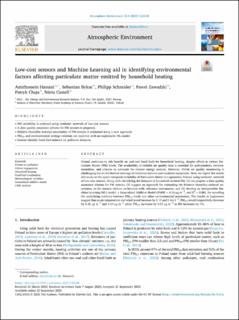| dc.contributor.author | Hassani, Amirhossein | |
| dc.contributor.author | Bykuć, Sebastian | |
| dc.contributor.author | Schneider, Philipp | |
| dc.contributor.author | Zawadzki, Paweł | |
| dc.contributor.author | Chaja, Patryk | |
| dc.contributor.author | Castell, Nuria | |
| dc.date.accessioned | 2023-11-01T09:56:31Z | |
| dc.date.available | 2023-11-01T09:56:31Z | |
| dc.date.created | 2023-10-21T12:56:06Z | |
| dc.date.issued | 2023 | |
| dc.identifier.citation | Atmospheric Environment. 2023, 314, 120108. | en_US |
| dc.identifier.issn | 1352-2310 | |
| dc.identifier.uri | https://hdl.handle.net/11250/3099928 | |
| dc.description.abstract | Poland continues to rely heavily on coal and fossil fuels for household heating, despite efforts to reduce Particulate Matter (PM) levels. The availability of reliable air quality data is essential for policymakers, environmentalists, and citizens to advocate for cleaner energy sources. However, Polish air quality monitoring is challenging due to the limited coverage of reference stations and outdated equipment. Here, we report the results of a study on the spatio-temporal variability of Particulate Matter in Legionowo, Poland, using residents’ network of low-cost sensors. Along with identifying the hotspots of household-emitted PM, (1) we propose a data quality assurance scheme for PM sensors, (2) suggest an approach for estimating the Relative Humidity-induced uncertainty in the sensors without co-location with reference instruments, and (3) develop an interpretable Machine Learning (ML) model, a Generalized Additive Model (RMSE = 6.16 μg m−3, and R2 = 0.88), for unveiling the underlying relations between PM2.5 levels and other environmental parameters. The results in Legionowo suggest that as air temperature and wind speed increase by 1 °C and 1 km h−1, PM2.5 would respectively decrease by 0.26 μg m−3 and 0.14 μg m−3 while PM2.5 increases by 0.03 μg m−3 as RH increases by 1%. | en_US |
| dc.language.iso | eng | en_US |
| dc.rights | Navngivelse 4.0 Internasjonal | * |
| dc.rights.uri | http://creativecommons.org/licenses/by/4.0/deed.no | * |
| dc.title | Low-cost sensors and Machine Learning aid in identifying environmental factors affecting particulate matter emitted by household heating | en_US |
| dc.title.alternative | Low-cost sensors and Machine Learning aid in identifying environmental factors affecting particulate matter emitted by household heating | en_US |
| dc.type | Peer reviewed | en_US |
| dc.type | Journal article | en_US |
| dc.rights.holder | © 2023 The Authors. | en_US |
| dc.source.pagenumber | 13 | en_US |
| dc.source.volume | 314 | en_US |
| dc.source.journal | Atmospheric Environment | en_US |
| dc.identifier.doi | 10.1016/j.atmosenv.2023.120108 | |
| dc.identifier.cristin | 2187077 | |
| dc.source.articlenumber | 120108 | en_US |
| cristin.ispublished | true | |
| cristin.qualitycode | 1 | |

